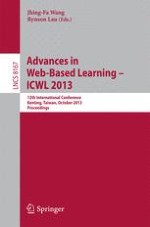This book constitutes the refereed proceedings of the 12th International Conference on Web-Based Learning, ICWL 2013, held in Kenting, Taiwan, in October 2013.
The 34 revised full papers presented were carefully reviewed and selected from about 117 submissions. The papers are organized in topical sections on interactive learning environments, design, model and framework of e-learning systems, personalized and adaptive learning, Web 2.0 and social learning environments, intelligent tools for visual learning, semantic Web and ontologies for e-learning, and Web-based learning for languages learning.
